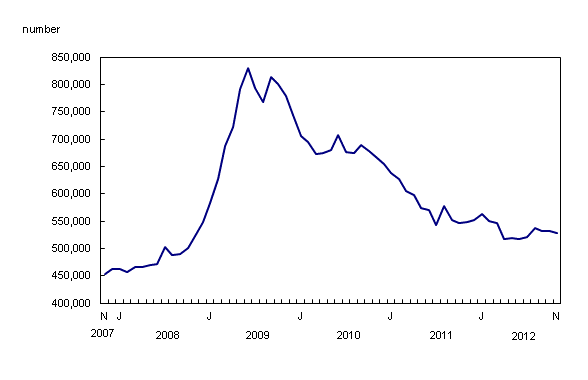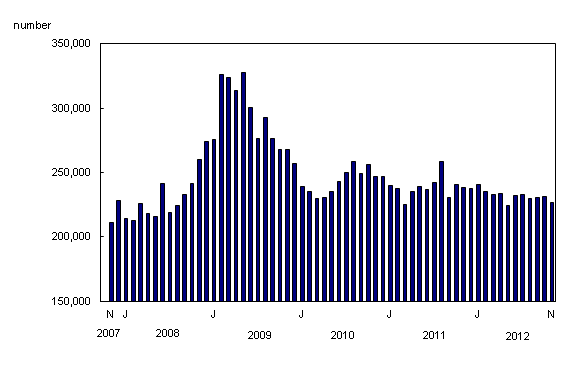Employment Insurance, November 2012
Archived Content
Information identified as archived is provided for reference, research or recordkeeping purposes. It is not subject to the Government of Canada Web Standards and has not been altered or updated since it was archived. Please "contact us" to request a format other than those available.
Related subjects
-
[an error occurred while processing this directive]
Following little change in October, the number of people receiving regular Employment Insurance (EI) benefits in November edged down 4,500 (-0.8%) to 528,000.
The number of beneficiaries decreased slightly in Nova Scotia, British Columbia, Ontario and Quebec. At the same time, there were slight increases in Alberta, Saskatchewan and Newfoundland and Labrador. There was virtually no change in the other provinces.
The number of Employment Insurance beneficiaries edges down in November

Chart description: The number of Employment Insurance beneficiaries edges down in November
Claims declined in November
To receive EI benefits, individuals must first submit a claim. The number of claims provides an indication of the number of people who could become beneficiaries.
Nationally, the number of initial and renewal claims fell by 4,400 (-1.9%) to 226,700 in November.
There were declines in eight provinces, with the most notable percentage decreases in Alberta (-6.7%), Nova Scotia (-4.1%), Saskatchewan (-3.7%) and Ontario (-3.1%). At the same time, the number of claims rose in Manitoba (+2.9%) and Quebec (+1.4%).
Fewer Employment Insurance claims in November

Chart description: Fewer Employment Insurance claims in November
Slight decrease in beneficiaries in four provinces
The number of people receiving regular benefits in November fell slightly in four provinces.
In Nova Scotia, the number of beneficiaries declined 1.6%, following small decreases in the two previous months.
The number of beneficiaries fell 1.2% in British Columbia, the third consecutive monthly decline.
There were also fewer people receiving regular benefits in Ontario (-1.1%) in November, following little change the month before.
In Quebec, the number of beneficiaries decreased 1.0% in November, offsetting an increase in October.
There were slightly more beneficiaries in three provinces in November: Alberta, Newfoundland and Labrador, and Saskatchewan.
In Alberta, the number of people receiving benefits was up 1.5%, the fifth consecutive monthly increase. The number of beneficiaries edged up 1.0% in Newfoundland and Labrador and in Saskatchewan.
Note to readers
Employment Insurance (EI) regular benefits are available to eligible individuals who lose their jobs and who are available for and able to work, but can't find a job. The change in the number of regular beneficiaries reflects various situations, including people becoming beneficiaries, people going back to work, and people exhausting their regular benefits.
All data in this release are seasonally adjusted unless otherwise specified. For more information on seasonal adjustment, see Seasonal adjustment and identifying economic trends.
EI statistics are produced from administrative data sources provided by Service Canada and Human Resources and Skills Development Canada. These statistics may, from time to time, be affected by changes to the Employment Insurance Act or administrative procedures. Recent examples are the pilot project entitled "Working While on Claim," introduced on August 5, 2012, and the regulation on search for suitable employment, that came into effect January 6, 2013.
The number of regular beneficiaries and the number of claims received for the current and previous month are subject to revision.
The number of beneficiaries is a measure of all people who received EI benefits from November 4 to 10. This period coincides with the reference week of the Labour Force Survey (LFS).
EI statistics indicate the number of people who received EI benefits, and should not be confused with LFS data, which provide information on the total number of unemployed people.
There is always a certain proportion of unemployed people who do not qualify for benefits. Some unemployed people have not contributed to the program because they have not worked in the past 12 months or their employment is not insured. Other unemployed people have contributed to the program but do not meet the eligibility criteria, such as workers who left their job voluntarily or those who did not accumulate enough hours of work to receive benefits.
New content and historical revision on the way
Over the next few months, data on people who receive regular EI benefits will be available for the first time by occupation and detailed age group.
New seasonally adjusted data by sex, age, census metropolitan area, census agglomeration and occupation will also be available.
Seasonally adjusted series will be revised back to January 1997 to reflect the most recent seasonal factors. Geography boundaries will be updated from the 2001 to the 2006 Standard Geographical Classification, which mainly affects boundaries of census metropolitan areas and census agglomerations.
In addition, the definition of regular beneficiaries will be expanded to include those receiving regular benefits while participating in employment benefit programs, such as training. Furthermore, self-employed people receiving special benefits will be included in the special benefits category.
All data will be available free of charge on CANSIM.
Available without charge in CANSIM: tables CANSIM table276-0001 to 276-0004, CANSIM table276-0006, CANSIM table276-0009 and CANSIM table276-0011.
Definitions, data sources and methods: survey number survey number2604.
Data tables are also now available online. From the Key resource module of our website under Summary tables, choose Subject, then Labour.
Data on Employment Insurance for December will be released on February 21.
For more information, contact us (toll-free 1-800-263-1136; infostats@statcan.gc.ca).
To enquire about the concepts, methods or data quality of this release, contact Vincent Ferrao (613-951-4750; vincent.ferrao@statcan.gc.ca), Labour Statistics Division.
- Date modified:
